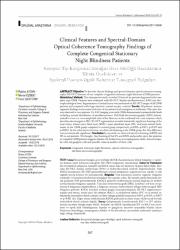| dc.contributor.author | Aydın, Rukiye | |
| dc.contributor.author | Özbek, Merve | |
| dc.contributor.author | Şentürk, Fevzi | |
| dc.date.accessioned | 2021-01-20T06:24:57Z | |
| dc.date.available | 2021-01-20T06:24:57Z | |
| dc.date.issued | 2018 | en_US |
| dc.identifier.citation | Aydın, R., Özbek, M. ve Şentürk, F. (2018). Clinical features and spectral-domain optical coherence tomography findings of complete congenital stationary night blindness patients. Turkiye Klinikleri Journal of Ophtalmology, 27(4), 267-272. https://doi.org/10.5336/ophthal.2017-59346 | en_US |
| dc.identifier.issn | 1300-0365 | |
| dc.identifier.issn | 2146-9008 | |
| dc.identifier.uri | https://doi.org/10.5336/ophthal.2017-59346 | |
| dc.identifier.uri | https://hdl.handle.net/20.500.12511/6304 | |
| dc.description.abstract | ABSTRACT Objective: To describe clinical findings and spectral domain optical coherence tomography (SD-OCT) features of our complete congenital stationary night blindness (CSNB) patients. Material and Methods: This retrospective study included 12 eyes of six patients diagnosed with complete type CSNB. Patients were evaluated with SD-OCT, fundus autofluorescence (FAF) and electrophysiological tests. Segmentation of retinal layers was performed on SD-OCT images of all CSNB patients and compared with 6 age matched, normal myopic controls. Results: All patients' anterior segments findings were normal and none of our patients had nystagmus or strabismus. Pale optic disc was observed in two patients. On FAF imaging eyes with CSNB demonstrated unremarkable fundi including normal distribution of autofluorescence. Full-field electroretinography (ERG) demonstrated b-wave to a-wave amplitude ratio of less than one in the combined rod–cone response which describes electronegative ERG. SD-OCT segmentation revealed statistically significant thinning of the total retina, retinal nerve fiber layer (RNFL), inner plexiform layer (IPL) and inner retinal thicknesses in the CSNB group compared to control group (respectively p=0.015, p=0.011, p=0.017 and p=0.021). In the other layers of retina, we observed thinning in the CSNB group, but this difference was not statistically significant. Conclusion: In our study we observed selective thinning of RNFL and IPL in our patients. We thought that thinning of the IPL and RNFL and possibly optic disc paleness in complete CSNB patients suggests bipolar cell dysfunction or synaptogenesis defect between bipolar cells and ganglion cells and possibly reduced number of these cells. | en_US |
| dc.description.abstract | ÖZET Amaç: Konjenital durağan gece körlüğü (KDGK) hastalarımızın klinik bulguları ve spektral domain optik koherens tomografi (SD-OKT) bulgularını tanımlamak. Gereç ve Yöntemler: Bu retrospektif çalışmaya, komplet tip KDGK tanısı alan altı hastanın 12 gözü dahil edildi. Hastalar SD-OKT, fundus otofloresans (FOF) ve elektrofizyolojik testlerle değerlendirildi. Tüm KDGK hastalarının SD-OKT görüntülerinde retinal tabakaların segmentasyonu yapıldı ve altı sağlıklı miyop kontrol ile karşılaştırıldı. Bulgular: Tüm hastaların anterior segment bulguları normaldi ve hastaların hiçbirinde nistagmus veya şaşılık yoktu. İki hastada optik disk soluk olarak gözlendi. FOF görüntülemede KDGK’lı gözlerde otofloresansın normal dağılımı ile birlikte normal fundus bulguları saptandı. Tam alan elektroretinografi (ERG), kombine rod-kon cevaplarında b dalgasının amplitüdünün a dalgasına oranının birden küçük olduğu elektronegatif ERG bulguları gösterdi. KDGK hastaları normal grupla karşılaştırıldığında SD-OKT segmentasyonunda total retina, retina sinir lifi tabakası (RSLT), iç pleksiform tabaka (İPT) ve iç retinal tabakalarda istatistiksel olarak anlamlı incelme olduğu görüldü (sırasıyla p=0,015, p=0,011, p=0,017 ve p=0,021 idi). Diğer retina tabakalarında KDGK grubunda incelme tespit edildi ancak bu fark istatistiksel olarak anlamlı değildi. Sonuç: Çalışmamızda hastalarımızda RSLT ve İPT tabakalarında incelme olduğu tespit edildi. Komplet tip KDGK hastalarında İPT ve RSLT'nin incelmesi ve optik disk solukluğunun, bipolar ve gangliyon hücreler arasındaki bipolar hücre fonksiyon bozukluğu, sinaptogenez defekti ve bu hücrelerin sayısındaki muhtemel azalmaya bağlı olduğu düşünüldü. | en_US |
| dc.language.iso | eng | en_US |
| dc.publisher | Türkiye Klinikleri Yayınevi | en_US |
| dc.rights | info:eu-repo/semantics/openAccess | en_US |
| dc.subject | Congenital Stationary Night Blindness | en_US |
| dc.subject | Optical Coherence Tomography | en_US |
| dc.subject | Full-Field Electroretinography | en_US |
| dc.subject | Konjenital Durağan Gece Körlüğü | en_US |
| dc.subject | Optik Koherens Tomografi | en_US |
| dc.subject | Tam Alan Elektroretinografi | en_US |
| dc.title | Clinical features and spectral-domain optical coherence tomography findings of complete congenital stationary night blindness patients | en_US |
| dc.title.alternative | Komplet tip konjenital durağan gece körlüğü hastalarının klinik özellikleri ve spektral domain optik koherens tomografi bulguları | en_US |
| dc.type | article | en_US |
| dc.relation.ispartof | Turkiye Klinikleri Journal of Ophtalmology | en_US |
| dc.department | İstanbul Medipol Üniversitesi, Tıp Fakültesi, Cerrahi Tıp Bilimleri Bölümü, Göz Hastalıkları Ana Bilim Dalı | en_US |
| dc.authorid | 0000-0002-4280-5718 | en_US |
| dc.authorid | 0000-0002-8851-6559 | en_US |
| dc.identifier.volume | 27 | en_US |
| dc.identifier.issue | 4 | en_US |
| dc.identifier.startpage | 267 | en_US |
| dc.identifier.endpage | 272 | en_US |
| dc.relation.publicationcategory | Makale - Ulusal Hakemli Dergi - Kurum Öğretim Elemanı | en_US |
| dc.identifier.doi | 10.5336/ophthal.2017-59346 | en_US |


















